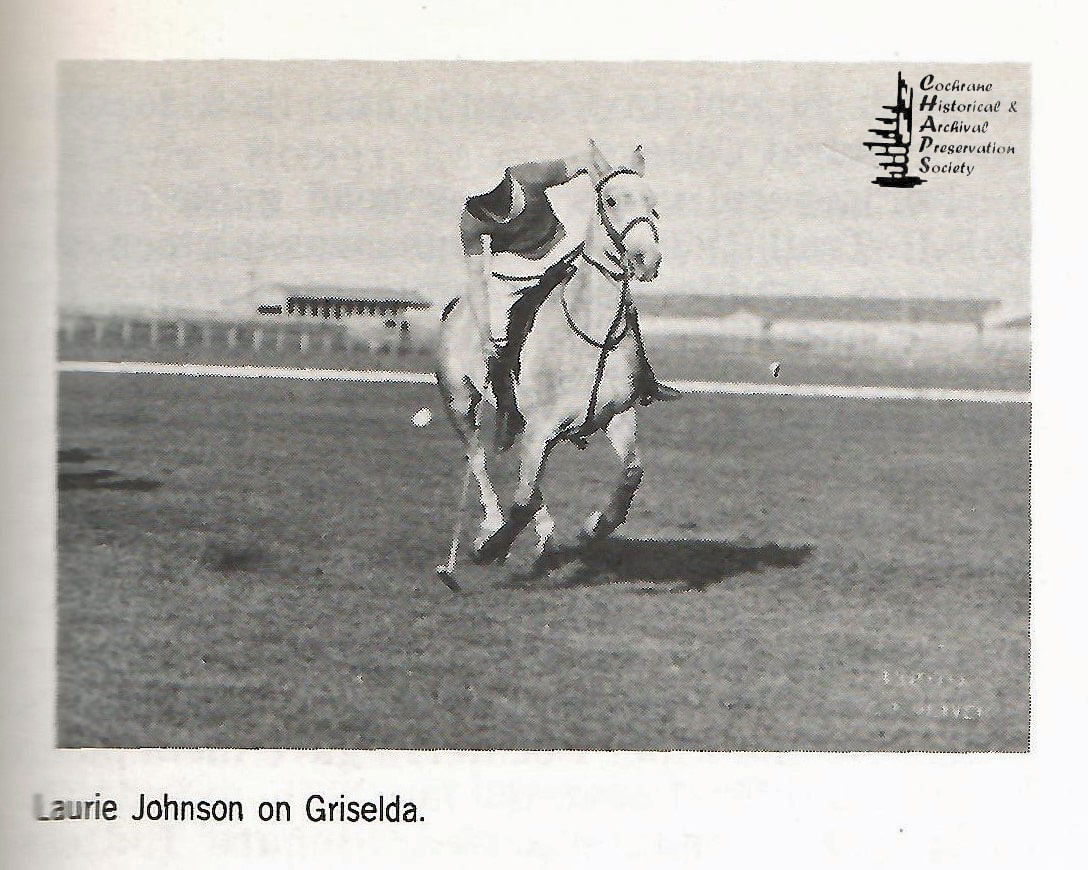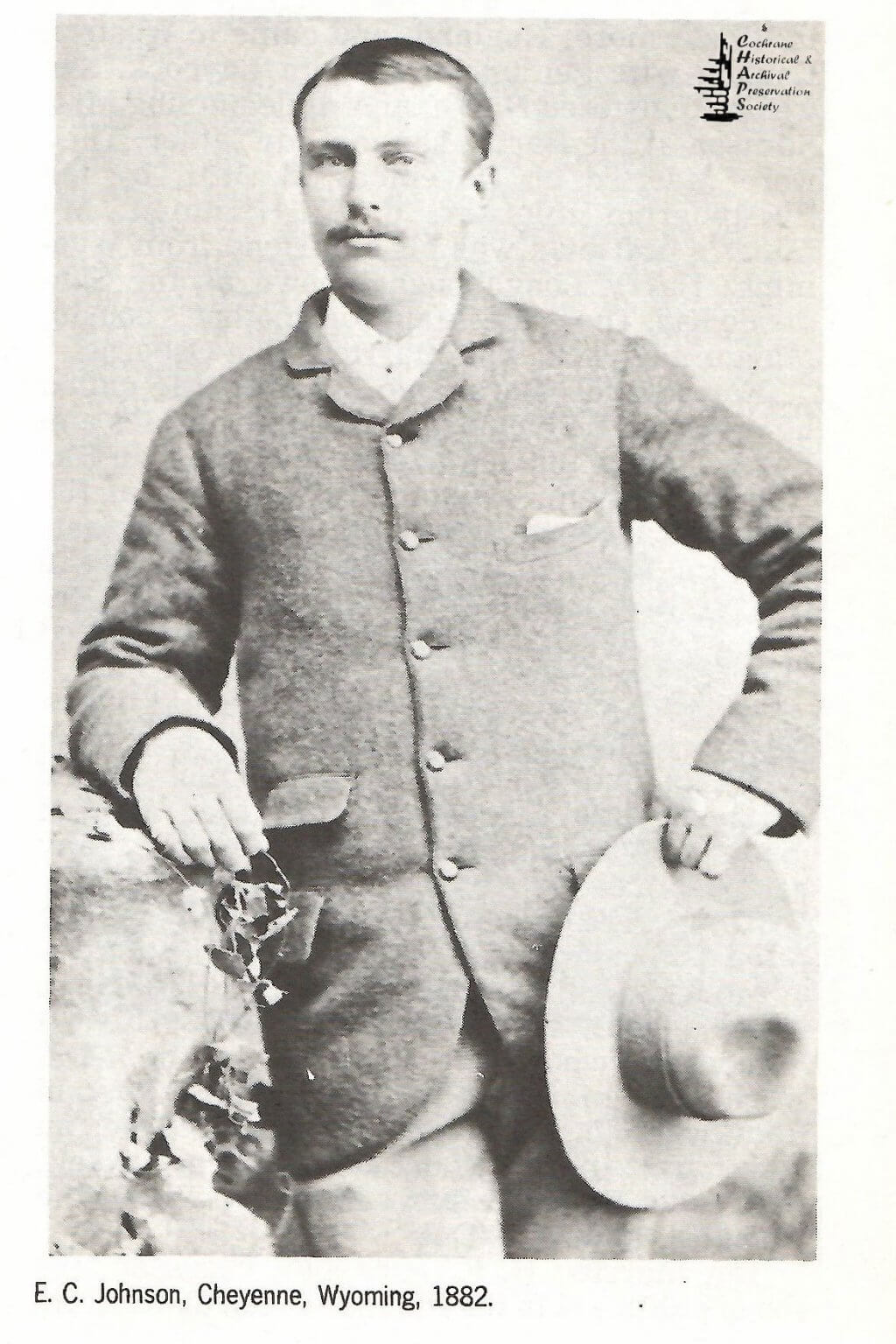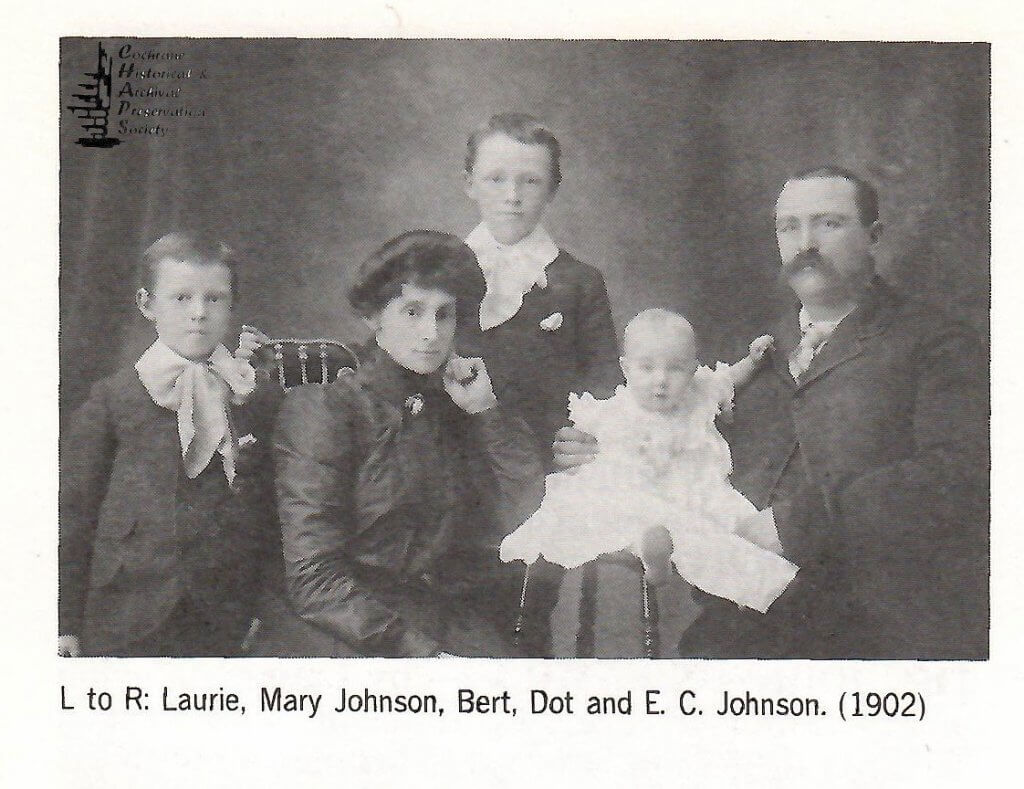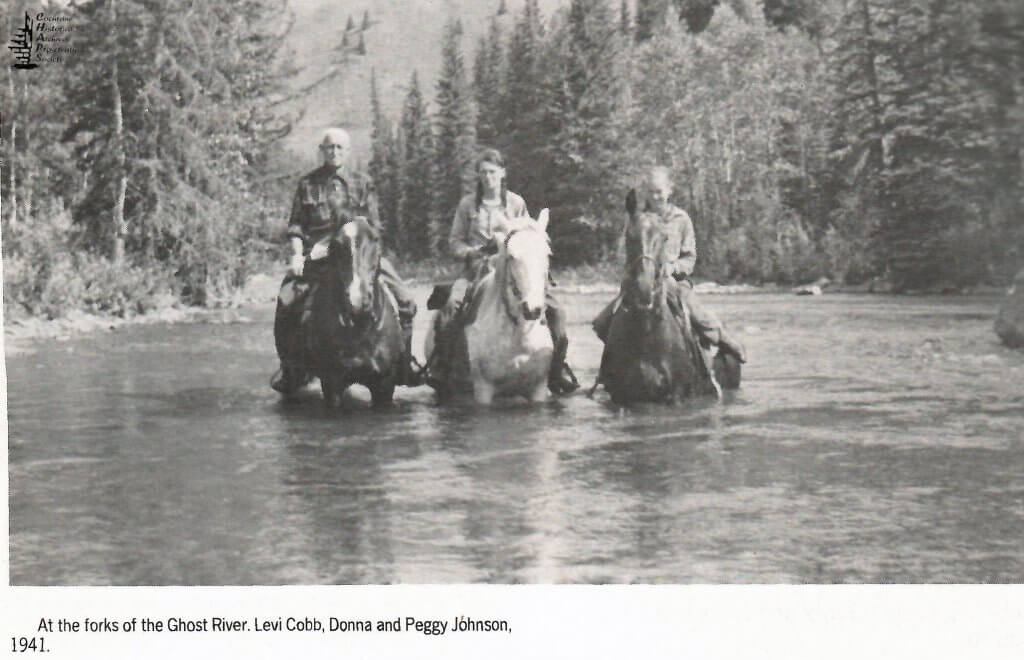– Laurie Johnson Big Hill Country
My father, Everett C. Johnson, was born in Virginia in 1860 and moved to Minnesota with his parents after the American Civil War. At the age of fifteen, he drove stagecoach in the Black Hills, and a year later he went to Wyoming where he rode with Bill Cody and Portugee Phillips. He went to work for the Powder River Cattle Company and was one of the three foremen under Fred Hess. He was captain of the roundup in Johnson County at the age of nineteen. He
became a friend and hunting companion of Owen Wister who used my father’s character and some of his adventures in the book “The Virginian.” In 1886 Hess sent him to Canada to locate a ranch for the 76. He returned to Wyoming but soon came back to Canada. In 1890 he was foreman of the North West Cattle Company under the manager, Fred Stimson, at the Bar U.
My mother, Mary Eleanor Bigland, was born in Windermere, England, and came to Western Canada with her uncle, William Laycock. She was a Registered Nurse, and while nursing Mrs. Stimson at the Bar U, she met my father. They were married on November 18, 1891, by the Presbyterian minister, J. C. Herdman. My father’s best man was his old friend from Wyo ming, Harry Longabough, known as the Sundance Kid. The bridesmaid was her mother’s cousin, Maggie Laycock, who married Blue Osborne.
For several years, Dad, as everyone called him, was a cattle buyer for Gordon, Ironsides and Fares, and he located and built up the Two Bar Ranch for them. I spent my early life at the d’Eyncourt Ranch where Dad was a partner. About 1904 we built a house on 18th Ave. in Calgary and Bert and I went to school at the Convent. Our elder sister went to school in the United States.
In 1910 my parents moved to Cochrane where Dad opened a butcher shop. When the Spanish Influenza epidemic broke out my mother turned our home into a hospital and nursed a great many in 1918 and 1919. She also delivered many babies during her years in Cochrane.
There were four children in the family: Jessie Lucretia who married John Annear, a locomotive engineer, and lived in Edmonton, where they raised nine children; Robert Everett Poindexter who went Overseas in the First World War, married Ona Patterson and lived in Banff where he had a service station and took an active part in the affairs of the town; myself, Laurence Branch; and Frances Olive, the youngest, known as Dot.
Dot married H. K. (Chappie) Clarkson, the son of oldtimers in the Pincher Creek district. He
owned the NW14 15 and SE14 22-26-5-5, on the highway west of Cochrane. Their two eldest children, Patricia and Robert were born there. Chappie moved his family to Turner Valley where he became a driller and worked in the oilfields for years. Three more children were born to them: Donald, Laurine and William.
Patricia and Robert both enlisted in the Army in World War Two. Patricia joined the C.W.A.C. and played the trombone in their brass band and did the comedy numbers. They played in cities all across Canada and gave concerts in England, France, Germany and in Apeldoorn, Holland, where they were stationed for several weeks.
Robert enlisted when he was sixteen and was a corporal before he left Calgary. In England, he held the middleweight boxing title for the Canadian forces and was a Commando instructor. By the end of the war, he was a Lieutenant. He went to work in the Leduc oilfields and was elected the first Mayor of Drayton Valley. He established the Clarkson Oilfield Construction Ltd., a very successful company, but he died at the age of thirty-nine, leaving his wife, Mona, three daughters and a little son.
I have spent most of my life in the Cochrane District. In 1917 after I left the Bar C, I went to work for D. P. McDonald, breaking workhorses and saddle horses. We brought some horses into the Calgary Horse Show where young Peter Welsh rode Smokey and I rode Osborne Johnson’s horse, Beaver, in performance jumping and in jumping pairs.
In 1918 the Parks Department took over the Ya-Ha Tinda, away up in the Red Deer River, and Jim Brewster had to get his horses out of there. He sold them to P. D. Bowlen, Norman Luxton and Bill Logan. Boney Thompson, Eddy Rowe and I gathered them and took them down to the Beaupré Ranch.
In 1919 Frank Wellman bought Tom Wilson’s Powderhorn horses which ran on the Kootenay Plains, up the North Saskatchewan River. Jack Fuller, Wat Potts, Bill Potts, Johnny Wilson and I went up with Wellman to gather them, taking Paul Beaver along as a guide. We stayed at the Wilson place where we were able to hold the horses as we gathered them. Paul, a Stoney Indian, was a great help to us. Once when the horses were about to get away down the river, he raced his horse along a high bank and jumped him far out into the river to head them off. Horse and rider went out of sight in the water for a moment or two, but he turned the horses. It was in May but the snow was very deep for much of the way as we trailed the horses south. Paul broke trail all the way, leading an old mare whose family of young stuff kept right with her. There were many broke horses in the bunch so every so often we would catch one and take it up to Paul so that he could have a fresh horse.
After we got back from the Kootenay Plains we took a large party up the Kananaskis. Frank Wellman, the outfitter, did not go but hired Bill
Potts as a guide and he and I did the cooking. The packers were Wat Potts, Jack Fuller, Marshall Baptie and Bobby Quigley. We started out from Morley with the party of publicity people: Murray Gibbon of the C.P.R.; Jack Lait, editor of the Chicago Tribune; Grantland Rice and his wife; Mr. Wheeler and his wife, and Charlie Towne, a poet. Byron Harmon was the movie cameraman and Dawson, the C.P.R. photographer, took the stills. On this trip, the idea of the C.P.R. Trail Ride was born. Later that year I took out two more parties, Henry Colgate and his wife on their honeymoon, and Bob and Sue Johnson (of Johnson & Johnson) on a hunting trip to the Clearwater country.
In 1923 John Hazza asked me to manage a Polo Pony Ranch for him, west of Calgary. There I schooled many good polo ponies, most of which were shipped to New York and Aiken, South Carolina. Some of these ponies played international polo.
In 1927, while foreman of the Rhodes Ranch in Grand Valley, I married Jean Lamont of Calgary who came west with her parents from Woodstock, Ontario, in 1912. While at the Rhodes Ranch we lived at the old Oddie place which Rhodes then owned. He sold it to Sherriffs. In 1930 I bought land along the Bow River, west of Cochrane. This was the S12 14 and the SE 14 15-26 5-5, which had been vacated by Lloyd Noland who had it under the Soldier Settlement Board. I leased two sections of Crown land in Big and Little Coulees.
Our buildings were on the river flat with a spring creek running between the house and the stables. By means of a furrow plowed along the sidehill from the spring, we were able to irrigate a large garden and the trees which we obtained from Indian Head, Saskatchewan: 100 ash, 100 elm and 375 caraganas. The hot, dry years of the Depression were upon us but we had plenty of vegetables which we could keep in good condition, a couple of milk cows and a large flock of hens.
Here are some figures and facts from Jean’s account book:
- 1931: Total for a year’s groceries, $127.60.
- Cream went down in price till special was only 17 ¢ per lb. butterfat.
- Eggs sold for 20 ¢ per dozen.
- Wheat sold: 549 bushels for $164.50.
- On Oct. 20th gave the Calgary Herald 10 bushels of wheat to pay for a subscription to the paper. The paper was thrown off a mile away up at the highway, by the Brewster Transport bus, every evening.
- We took wheat to a flour mill and paid for the milling with wheat. We got flour, middlings, shorts and bran.
- On Oct. 29th sold to R. B. Rogers: 100 lbs. of carrots $1.50; 90 lbs. of turnips 90¢; 75 lbs. of potatoes 75¢; 60 lbs. of cabbage 90¢`; Total $4.05.
- Income for the year: $882.77, mostly from the sale of horses.
- Total expenses for the year: $741.45.
- 1932: Things were tougher.
- Total for a year’s groceries: $91.60 (100 lbs. flour $2.25, 100 lbs. sugar $5.50, 5 lbs. tea $1.95, 5 lbs. coffee $1.85.)
- Total for clothes $13.09.
- Cream, graded special, was as low as 14¢.
- Sold Johnny Morrison 250 lbs. carrots and turnips for $2.50.
- Total income: $441.71; total expenditures $428.55.
We still played polo, went on hunting trips and had parties and dances. R. B. Rogers, Duncan and Archie Kerfoot and the Rhodes Ranch had tennis courts and gave very enjoyable tennis parties. We often had dinner parties in those days, and I remember one at R. B. Rogers’ when Pierre Eyma, a new neighbour in the district, arrived in formal dinner clothes. It did not take him long to get used to our strange ways.
In 1933 I leased the old Coleman Ranch from my cousin, Ruth Laycock. It was seventeen hundred acres in extent and took in Lot 5 of Morleyville Settlement. In 1885 Lucius Coleman was living in the Adams house, later owned by Jack McDonald. Two years later he built a large log house on the E 12 20-26-6-5. We moved into this house and lived there for three years. In 1933 Duncan Kerfoot was instrumental in getting my team on for the building of the Banff-Jasper Highway. They went up again in 1934, and I took them up myself and worked there in 1935 when the pay was much better. In 1936 there was a change of government, and we were told that our horses were Conservatives and could not work there. They were the best Conservatives that ever looked through a bridle.
In 1934 my wife bought the NW14 8-28-6-5 and homesteaded the NE 14 of 7 adjacent to it. She camped there for four summers on a creek that flowed into Rabbit Creek and it became known as Jean’s Creek. I homesteaded the SW14 17-27-6 5, and we took a twenty-year lease on three sections of Crown land. Guy Gibson put up the logs and built the fieldstone fireplace for the house on my homestead, the Lazy JL. We moved there in 1936 and finished building the house. Our daughters, Donna Carroll and Margaret Jean got their education by Correspondence School from Edmonton till the younger of the two went
to High School in Calgary and then to Olds Agricultural College.
For several years I was the head guide on the C.P.R. Trail Ride. When Donna was thirteen, she came as a guide, taking complete charge of ten horses and riders. She guided in the mountains for three years and always trailed our horses up and back, alone. From 1939 till the girls left home we took in dudes, mostly children, every summer. In this way, the girls were able to associate with young people from all over Canada and some from the United States and England. Every Saturday during the winter, they rode the ten miles down to Pocaterra’s where Norma Piper Pocaterra gave them piano lessons and Mr. Pocaterra taught them Spanish.
In 1950 Donna married Richard Butters whose grandfather came to Alberta in 1883. Richard had a ranch, the OC, which joined our land on the south. Late in 1964 Donna and Richard bought our land and cattle to add to their own and moved up to the Lazy JL. They have three sons: Erik, Lamont and Ian.
Our younger daughter, Peggy, also lives in the Cochrane District. She spent two years in the Navy at Halifax where she married Lieutenant Commander S. R. Wallace. He is now with the University of Calgary and they live just east of
Cochrane on the Lochend Road. They have three children: Robert, Laurence and Carolyn.
On June 7, 1975, Erik Butters and Wendy Fenton were married and went to live at the OC Ranch. Wendy is the daughter of Mr. and Mrs. Lynn Fenton.






